
TransCelerate’s eLabeling Initiative
In this interview, Craig Lipset, Head of Clinical Innovation at Pfizer, discusses the impact of TransCelerate’s eLabeling Initiative.
Moe Alsumidaie: Can you describe the technologies that will be used in the eLabeling Workstream?
Craig Lipset: When this workstream was originally being scoped, several TransCelerate member companies came together and initially focused on leveraging technologies to enhance clinical medication labels. At that time, many individual member companies had been
doing experiments to explore exciting and valuable content accessible on mobile for different stakeholders. The intention was to better interact with the investigational products, and engage personnel at pharmacy, provider, investigator and patient levels. As the group collaborated and began to scope out opportunities, there was a lot of enthusiasm around the technology, with a great understanding that the barriers towards implementing the opportunities were not about the technologies themselves, but rather how to continue the incredible evolution in the way we conduct clinical research.
Specifically, prioritized opportunities were largely around taking a consistent approach in engaging regulators. For instance, a proposed approach may be that there is a certain consistency around the label, so that we can nicely transfer that information to an electronic format. By engaging with regulators, we aspire to align our approaches with their needs as the industry starts to move in that direction. The eLabels Initiative itself is almost surprisingly low-tech because we’re trying to enable a diverse ecosystem of technology to improve label content distribution and comprehension through partnership with health authorities.
The eLabels Initiative is not currently committed toward building any kind of technology, but that could evolve over time. This is not like TransCelerate’s Shared Investigator Platform, where there is a technology product as an output; the eLabels Initiative is more aligned with how TransCelerate introduced the Risk Based Monitoring (RbM) Initiative. RbM requires an underlying technology, nonetheless, that’s not being developed and provided by TransCelerate; TransCelerate paved the way for RbM tools and processes to be correctly used by companies in collaboration with regulators. Now, different approaches can be incorporated into RbM.
This is the same type of roadmap that we envision with eLabels. I expect different mobile tools will continue to evolve, and maybe there will be a time where TransCelerate can do more with the technology itself. However, at this stage it is focused on ensuring a process, similar to RbM, which will enable novel technologies to be used.
MA: You indicate that “the eLabeling effort will make product information more accessible to patients and permit deeper engagement during the clinical trial process.” Can you elaborate on how eLabeling will be used to enhance patient engagement?
CL: Today’s labeling information is not leveraging the range of technologies currently available that can provide truly engaging content for patients. What we’re aspiring to do with the eLabels Initiative, is to leverage different ways that information can be delivered
through the use of technology, such as mobile, where it is easier to consume--whether it’s the printed word, or multimedia or otherwise.
Additionally, we are experiencing great advancements and learnings in other adjacent areas, where we’ve moved from paper to electronic; all of a sudden we can get back analytics and insights. For example, one of the great things about electronic informed consent, is we can understand how much time patients are spending with the consent, and which sections and terms do patients find confusing. The electronic platform enables learnings from patients in aggregate, which helps us make the consent better. To understand how the patient actually interacts with a label is one of the first opportunities to get back real world learnings and analytics, and this allows us to make the labeling information better for the patient.
MA: Will the eLabels Initiative focus on clinical trials, post-marketing applications or both?
CL: We initially want to focus our eLabels efforts in clinical trials and the investigational medicine supply chain because of its complexity, including country-specific requirements for clinical trial labels. This information gets very complicated when there are multifaceted dynamics for adaptive studies; for example, packages do get changed as we learn other information about the medicine during the trial that requires the label to be updated. We do see a lot of labeling challenges in clinical trials that can be addressed through the eLabeling Initiative.
MA: How can eLabeling affect study sites financially? How will eLabeling improve clinical trial quality?
CL: From a financial standpoint, I couldn’t say definitively … but I expect that there is some burden to the site associated with re-labeling management when investigational medicine has to be pulled back due to required updates. Certainly in terms of quality and saftey, having that higher degree of confidence around a proper use of medication can only be a positive for our patients and sites.
What we’re seeing here is an opportunity and a path forward. As we think about the patient, the eLabeling Initiative is one of what will ultimately be a number of novel patient engagement solutions driven by technology that will ultimately provide (1) a better patient experience, (2) to improve the efficiency of study conduct and (3) offer new data and insights for our researchers. eLabeling, as well as a range of other digital technology applications, are areas that we are continuing to explore as it relates to clinical trials operations.
Newsletter
Stay current in clinical research with Applied Clinical Trials, providing expert insights, regulatory updates, and practical strategies for successful clinical trial design and execution.






.png)



.png)



.png)
.png)
